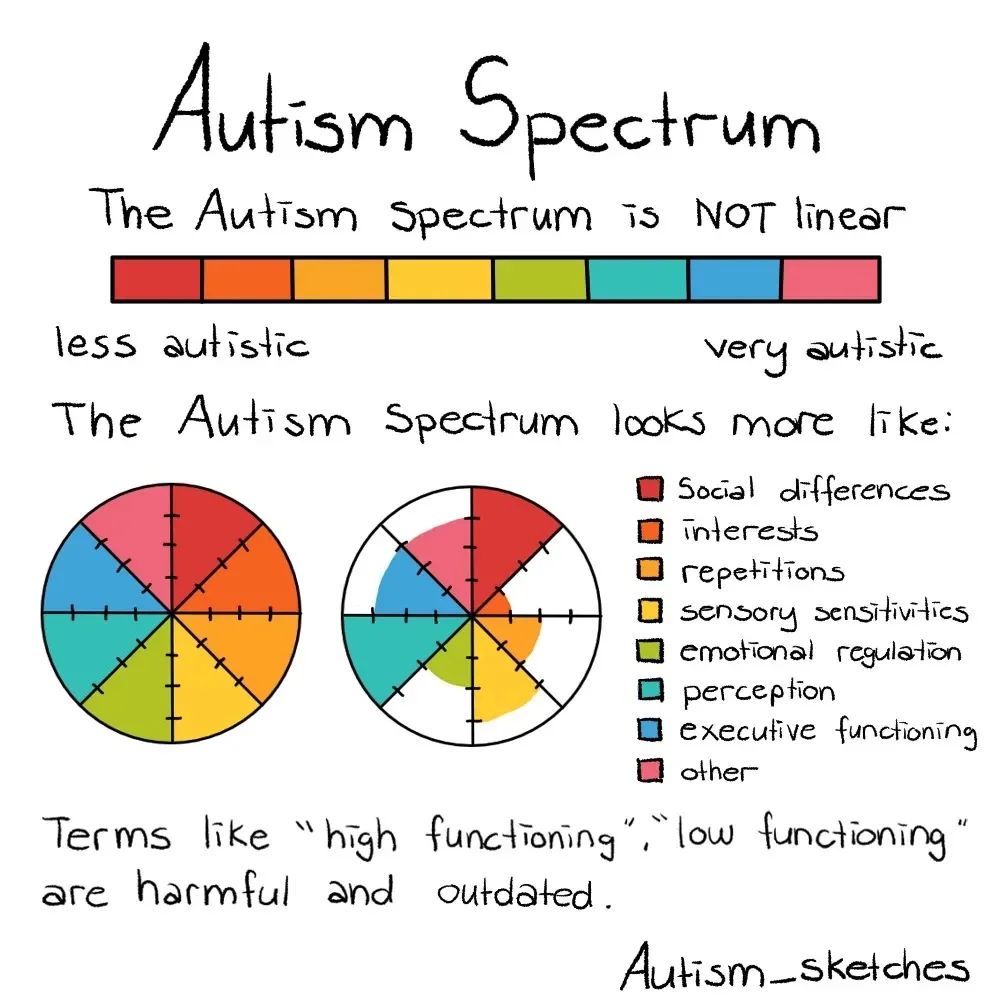
Ask DadPad, Being a Dad, Parenting Advice
Ask DadPad: What is autism and how can I best support my autistic loved ones?
Posted on 8th April 2024
For this year’s World Autism Acceptance Week, Georgie has written a second blog post for us on autism. This time looking at ways in which a non-autistic dad can better help support his partner and/or child(ren) with autism, it’s a follow-up to her piece from 2022, which focused on the ways in which a person could support either themselves or their autistic partner as they become a new parent.
Introduction
Autism Spectrum Disorder (ASD) is a neuro-developmental condition that affects how individuals perceive the world, communicate, and interact with others.
We don’t know exactly what causes autism, although it is thought to be caused by a mixture of genetic and environmental factors.
For dads with autistic children or partners, understanding and supporting them is essential for their wellbeing and growth.
In this DadPad blog, we’ll delve into what autism is and explore practical ways dads can provide support and create a nurturing family environment for their child or partner.
What is autism?
Autism is a spectrum condition, meaning it presents differently in every autistic person. The autism spectrum isn’t a linear presentation; it’s unique to the individual and is best presented as a wheel of variable strengths and challenges.

Image from: @autism_sketches – https://www.instagram.com/p/Cb2ykmTM0TN/
Common characteristics include:
- social interaction and communication differences;
- repetitive and restrictive behaviours;
- highly-focused interests;
- executive functioning differences;
- emotional regulation challenges; and
- sensory sensitivities.
It is important to recognise that – even though autism is officially classed as a ‘disorder’ in the Diagnostic and Statistical Manual of Mental Disorders (DSM- 5) – it is not a disease or a flaw.
The diagnostic criteria for autism is based on a ‘deficit-based model’ of identification, which means that the assessment focuses on the person’s challenges rather than their strengths (despite the fact that all autistic people have strengths, as well as challenges).
Autistic people are now challenging the medical language used by healthcare professionals to describe autism, and many prefer using the term ‘condition’ in place of the word ‘disorder’ (which is why you may see the alternative acronym ASC, instead of ASD).
Remember! Autistic people aren’t broken: they simply have a different way of experiencing the world.

Supporting your autistic child
Coming to the realisation that you may have an autistic child can be a challenging process for any parent to go through. There are many reasons why this might be the case; however, it’s important to find the ‘right’ family member, friend, healthcare or education professional to raise your concerns with. Unfortunately, there are still people who have pre-conceived or misinformed views about autism, but awareness and attitudes are changing quickly, thanks to more and more autistic people speaking up to share their lived experiences. If you approach a professional and find that what you raise is being minimised or dismissed, don’t be put off. Instead, ask for a second opinion, or try a different service/professional.
If you are concerned about your child’s development, you can raise it with your Health Visitor, EYFS (Early Years Foundation Stage) Practitioner, Family GP, School Nurse, SENDCO (Special Educational Needs and/or Disability Co-ordinator) or paediatrician (if your child is already under the care of a paediatric consultant).
You can also contact your local Early Help Hub to self-refer to a specialist healthcare professional who should be able to access the support and make the relevant referrals your child may need. You will find details of the support and interventions on offer locally to you by searching for ‘[the name of your local authority] local offer’. For more information on what the local offer is, please see the Council for Disabled Children’s explanation.
The good news is you don’t have to go through the formal diagnostic process to access the right support and intervention for your autistic child (although the formal diagnostic report you receive after assessment usually provides a written insight into your child’s world and signposting for parents/carers/educators on how to support your child best).
This is because reasonable adjustments for your child can easily be put in place at home, nursery or school without any formal diagnosis. These are the first steps a well-informed healthcare professional, EYFS practitioner or school educator will usually recommend, before you make any decisions about whether referral for autism assessment is right for your child (this stage is often referred to as ‘watchful waiting’ and is used to observe a child and collect the relevant evidence that would support a referral for assessment).
You may also be offered a parenting course by your Local Authority in order to be able to meet the needs of your child better whilst you wait for further support or intervention.

Here are DadPad’s top tips on what you can do to support your autistic child…
- Educate Yourself – Take the time to learn about autism, its traits, and how it manifests in your child. Understanding their unique strengths and challenges will help you be able to provide better support;
- Foster Open Communication – Communication may look different for autistic children. Be patient and open to different forms of expression, whether verbal or non-verbal. Encourage your child to communicate in ways that are comfortable for them;
- Establish Routine and Structure – Autistic children often thrive in predictable environments. Establishing routines and maintaining consistency can help reduce anxiety and provide a sense of security;
- Respect Sensory Differences – Many autistic individuals have sensory processing differences, which can make certain stimuli overwhelming. Be mindful of your child’s sensory triggers and create a sensory-friendly environment at home;
- Celebrate Achievements – Acknowledge and celebrate your child’s achievements, no matter how small they may seem. Positive reinforcement can boost their confidence and motivation;
- Advocate for their needs – Stand up for your child’s needs and rights in various settings, whether it is at nursery, at school, with family, or in social situations. Advocate for accommodations that will support their well-being.

Supporting an Autistic Partner
Your partner may or may not have a formal autism diagnosis and that’s OK. Understanding and attitudes towards autism will have changed since they attended school and their autistic traits may have been missed or mis-diagnosed (often as anxiety, depression or another neurodivergent condition).
This is particularly true for women and people from minoritised backgrounds as autism has historically been under-researched in women and people of colour because it was once believed to be a condition that only affected white, male children. We now know that autism is a lifelong condition that can affect any person, regardless of their gender or colour of their skin.
Many women learn to ‘mask’ their autistic traits in childhood because of societal expectations towards women and girls. It’s therefore more common for women to go through a process of ‘late-realisation’, when the pressures and demands of life become too overwhelming and they are unable to continue hiding their traits (e.g. the transition to adulthood, motherhood and menopause etc).
For more information on ‘masking’ please visit The National Autistic Society’s information page.
Even though your partner may not have a formal diagnosis, self-diagnosis is still valid. Referral and waiting lists for adult autism assessment are long in the UK, due to a national shortage of adult assessors and an increasing number of people requesting referral for assessment. Many adults still go on to undergo diagnostic assessment though through the NHS or a private provider as it can be a validating experience to receive a diagnosis and a key part of understanding and learning to look after themselves better.
The good news is your partner can still receive/request reasonable adjustments at college, university, work and within medical settings without a formal diagnosis. However, your partner may not be ready for other people to know about their condition and it’s important to respect their wishes if this is the case. For more information on what reasonable adjustments are please visit The National Autistic Society’s information page.
You may find that your partner’s autistic traits fluctuate depending on their day-to-day experiences and environment, and you may also find that they appear to be ‘more autistic’ after experiencing their own ‘self-realisation’, or in certain situations. This is normal, because each autistic person has their own unique strengths and challenges, and they may be more affected by their autism depending on their stress levels or the environment they are in.
Remember! Autistic people aren’t automatically classed as disabled – even though the condition is a valid disability – as they may not be impacted by their condition all the time or see themselves as disabled. Many autistic people don’t feel that they aren’t disabled as such, but that the environment/situation that they are in disables them.

Here are DadPad’s top tips on what you can do to support your autistic partner…
- Listen and Validate – Create a safe space for open communication. Listen attentively to your partner’s feelings and experiences, and validate their emotions without judgment;
- Respect Boundaries – Understand that your partner may need more rest, alone time or specific routines to feel comfortable and well. Respect their boundaries and support them in creating a space where they feel safe and understood;
- Be Flexible and Patient – Flexibility is key when supporting an autistic partner. Be patient and understanding when plans change, or unexpected challenges arise;
- Advocate for Their Needs – Stand up for your partner’s needs and rights in various settings, whether it is at work, with family, or in social situations. Advocate for accommodations that will support their well-being;
- Practice Self-Care – Supporting an autistic loved one can be rewarding but also challenging. Remember to prioritise your own well-being and seek support when needed. Taking care of yourself will enable you to better support your partner.

Conclusion
Being a dad to an autistic child or partner comes with its own set of joys and challenges. By understanding autism and implementing supportive strategies, you can create a loving and nurturing environment where your loved one(s) can thrive.
Remember, though, that every individual with autism is unique, so it is essential to approach support with empathy, patience, and a willingness to learn and adapt.
References and Further Reading:
https://www.instagram.com/autism_sketches/ and https://autismsketches.carrd.co/.
Council for Disabled Children (2019) Local Offer Guide (online).
National Autistic Society (undated) Asking for reasonable adjustments (online).
National Autistic Society (undated) Masking (online).
Council for Disabled Children:
National Autistic Society:
NICE (National Institute for Health and Care Excellence) Guidance:
- Autism spectrum disorder in adults: diagnosis and management (2012)
- Autism spectrum disorder in under 19s; recognition, referral and diagnosis (2011)
- Autism spectrum disorder in under 19s: support and management (2013)

